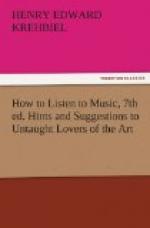[Music illustration]
and also in the last movement:
[Music illustration]
More than this, we find the motive haunting the first movement of the pianoforte sonata in F minor, op. 57, known as the “Sonata Appassionata,” now gloomily, almost morosely, proclamative in the bass, now interrogative in the treble:
[Music illustration]
[Sidenote: Relationships in Beethoven’s works.]
[Sidenote: The C minor Symphony and “Appassionata” sonata.]
[Sidenote: Beethoven’s G major Concerto.]
Schindler relates that when once he asked Beethoven to tell him what the F minor and the D minor (Op. 31, No. 2) sonatas meant, he received for an answer only the enigmatical remark: “Read Shakespeare’s ‘Tempest.’” Many a student and commentator has since read the “Tempest” in the hope of finding a clew to the emotional contents which Beethoven believed to be in the two works, so singularly associated, only to find himself baffled. It is a fancy, which rests perhaps too much on outward things, but still one full of suggestion, that had Beethoven said: “Hear my C minor Symphony,” he would have given a better starting-point to the imagination of those who are seeking to know what the F minor sonata means. Most obviously it means music, but it means music that is an expression of one of those psychological struggles which Beethoven felt called upon more and more to delineate as he was more and more shut out from the companionship of the external world. Such struggles are in the truest sense of the word tempests. The motive, which, according to the story, Beethoven himself said indicates, in the symphony, the rappings of Fate at the door of human existence, is common to two works which are also related in their spiritual contents. Singularly enough, too, in both cases the struggle which is begun in the first movement and continued in the third, is interrupted by a period of calm reassuring, soul-fortifying aspiration, which in the symphony as well as in the sonata takes the form of a theme with variations. Here, then, the recognition of a simple rhythmical figure has helped us to an appreciation of the spiritual unity of the parts of a symphony, and provided a commentary on the poetical contents of a sonata. But the lesson is not yet exhausted. Again do we find the rhythm coloring the first movement of the pianoforte concerto in G major:
[Music illustration]
Symphony, concerto, and sonata, as the sketch-books of the master show, were in process of creation at the same time.
[Sidenote: His Seventh Symphony.]
Thus far we have been helped in identifying a melody and studying relationships by the rhythmical structure of a single motive. The demonstration might be extended on the same line into Beethoven’s symphony in A major, in which the external sign of the poetical idea which underlies the whole work is also rhythmic—so markedly so that Wagner characterized it most happily and truthfully when he said that it was “the apotheosis of the dance.” Here it is the dactyl, [dactyl symbol], which in one variation, or another, clings to us almost as persistently as in Hood’s “Bridge of Sighs:”




